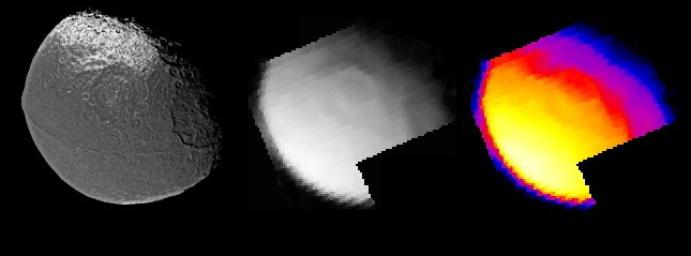
|
Iapetus Thermal Radiation Image
- Click the image above for a larger view
- Full-Res JPEG (645 x 239) (16.2 kB)
- Full-Res TIFF (645 x 239) (196.5 kB)
Caption:
This image of the infrared heat radiation from Saturn's moon Iapetus was obtained by the Cassini composite infrared spectrometer instrument 16 hours before Cassini's closest approach to this mysterious moon, on December 31, 2004. The thermal radiation is shown as both a grayscale image, equivalent to what we would see if our eyes were sensitive to infrared wavelengths near 15 microns, and as a color-coded temperature map. A previously-released mosaic obtained by Cassini's imaging camera shortly before the composite infrared spectrometer observation, with similar scale and orientation, is also shown for comparison.
Temperatures reach nearly 130 Kelvin (-226 Fahrenheit) at noon on the equator on the dark material that covers most of this side of Iapetus, making high noon on Iapetus's dark side probably the warmest places in the Saturn system. This is much warmer than temperatures on another Saturnian moon, Phoebe, measured by composite infrared spectrometer in June 2004. Those Phoebe temperature measurements peaked near 112 Kelvin (-258 Fahrenheit), because though Phoebe is almost as dark as Iapetus's dark material and absorbs nearly as much sunlight, Phoebe rotates much more quickly (once every 9 hours, compared to 79 days for Iapetus). That means the surface has less time to heat up during the day. Temperatures on Iapetus's bright material are much colder, peaking near 100 Kelvin (-280 Fahrenheit), both because the bright material absorbs less sunlight and because it is further from the equator on this side of Iapetus. Temperatures in the large crater near the center of the disc are slightly different from those in surrounding areas, because sloping surfaces within the crater are warmer where they are tilted towards the Sun and cooler when tilted away from the Sun.
Background Info:
The Cassini-Huygens mission is a cooperative project of NASA, the European Space Agency and the Italian Space Agency. The Jet Propulsion Laboratory, a division of the California Institute of Technology in Pasadena, manages the mission for NASA's Science Mission Directorate, Washington, D.C. The Cassini orbiter and its two onboard cameras were designed, developed and assembled at JPL. The composite infrared spectrometer team is based at NASA's Goddard Space Flight Center, Greenbelt, Md.
For more information about the Cassini-Huygens mission visit, http://saturn.jpl.nasa.gov and the instrument team's home page, http://cirs.gsfc.nasa.gov/. .
Cataloging Keywords:
| Name | Value | Additional Values |
|---|---|---|
| Target | Iapetus | Phoebe, Saturn |
| System | Saturn | |
| Target Type | Satellite | Irregular, Planet |
| Mission | Cassini-Huygens | |
| Instrument Host | Cassini Orbiter | |
| Host Type | Orbiter | |
| Instrument | Composite Infrared Spectrometer (CIRS) | |
| Detector | ||
| Extra Keywords | Color, Crater, Infrared, Map, Rotation, Thermal | |
| Acquisition Date | ||
| Release Date | 2005-01-10 | |
| Date in Caption | 2004-12-31 | |
| Image Credit | NASA/JPL/GSFC | |
| Source | photojournal.jpl.nasa.gov/catalog/PIA07004 | |
| Identifier | PIA07004 | |

